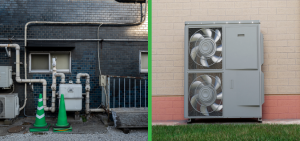How To Know If It’s Time To Replace Your Water Heater
Your water heater is the unsung hero of your home’s plumbing system. Consider this – every day, this trustworthy equipment works diligently to provide you and your family in San Diego with all of the hot water you demand.

Your life would grind to a halt if you didn’t have a water heater, from having a hot shower in the morning to cleaning the dishes in the evening. That’s an effective performance in our opinion.
Even legends, however, must retire at some time. Regular water heater maintenance can help to extend the life of your heater, but it cannot last forever. Your water heater’s sudden demise interrupts your daily routine and, if the tank itself leaks, may cause water damage. As a result, many homeowners choose water heater replacement before it fails.
While many water heater issues may be fixed, all heaters will eventually need water heater replacement services in San Diego.
Seven Signs That It’s time To Call For Water Heater Replacement:
1. Abnormal Noise
As sediment builds up in a water heater tank, the obstruction can result in abnormality. When sediment accumulates in a water heater tank, it might cause odd sounds during the heating process. Your water heater may be making banging or rumbling noises.
While a modest quantity of accumulation may be cleaned by a plumbing specialist in San Diego, the silt hardens with time. A buildup of hard sediment can render your heater ineffective and noisy, demanding a replacement.
When the system works hard, sediment buildup in your water heater generates these noises. Water heaters in houses with hard water are especially prone to sediment buildup.
2. Age
The average water heater has a lifespan of around 15 years. If you know when the water heater was installed, consult your owner’s handbook to discover how much longer the equipment may be expected to endure.
If you don’t know when you installed the existing heater, a plumber may be able to help you narrow down the time range. In general, the age of the water heater is only relevant if you have also begun to notice other symptoms on this list.
Bottom line: your home’s hot water heater is approaching its 10th anniversary and is suffering from other concerns too, it’s time to retire the device.
3. Corroded Fittings
Even though water heaters are designed to endure moisture and high temperatures, the persistent flow of water can wear out specific components over time. Corrosion is more likely if there are leaks around the valves or piping.
If the fittings surrounding your water heater are rusty or worn down, this might signal a problem with the device as a whole. A plumber can assist you in determining whether the problem can be resolved by replacing the damaged element or whether the corrosion suggests a more significant problem.
If you find yourself swimming in rust or picking it off your dining plates, your stomach will churn.
This problem occurs when the interior components of your water heater get so corroded that rusty bits wind up everywhere. This annoying experience alone is enough to make you want to install a new one, regardless of the fact that it’s likely to go down forever.
4. Extensive Leaks
While your water heater handles a lot of water, that water should never be visible when you look at it. Chances of the broken tank are there if you detect pools of water surrounding the heater or water leaking down the sides of the heater.
In most situations, you need to replace the water heater to eliminate leaks and avoid possible water damage.
If you see a small quantity of water leaking from your water heater, it’s an indication that you need to call professionals for water heater replacement in San Diego. A little leak alerts you to the risk of an expensive interior flood.
5. Inadequate Hot Water
A shortage of hot water can be caused by a variety of factors, including faulty water heater settings. If you observe a rapid drop in the amount of hot water, the water heater may no longer be operating properly.
If you observe that your hot water never gets hotter than lukewarm, this might be a sign of a faulty heater.
Previously, every member of your family in San Diego could have a hot shower in the morning. At least one or two people will now receive the short end of the stick—and a cold shower.
The primary cause of this symptom is a decay of components or silt calcifying in the tank. The minerals occupy a crucial place, reducing the amount of space available for hot water. However, this is a significant signal that your water heater is going to fail.
6. Several Repairs
The solution to many appliance problems is available with simple repairs. However, if an appliance requires repeated repairs to work properly, it may be a better investment to replace it rather than spend additional money on it.
Start preparing for a replacement if your water heater has had several repairs in the previous one to two years.
7. Subpar Water Quality
Because all of your hot water is routed through the heater, problems with the water heater may have an impact on the quality of your water. Your water heater may be failing if your water appears muddy or rusty, smells metallic, or tastes weird.
Allow a plumber to inspect the water heater to find the source of the water-quality problem.
You now know what you’re looking for, what you’re listening for, and what you’re tasting. Keep an eye out for anything out of the usual with your hot water. One of the seven indicators that you need to install a new water heater might be provided by your trusty appliance.
Your water heater failing unexpectedly can disrupt your life for a few days. So, you need to take optimum care of your water heater to avoid sudden failures.
How To Care For Your Water Heater:
In most cases, the water heater maintenance goes unseen. You don’t spend as much time learning about or knowing how to maintain them as we do our air conditioners and other more typical house maintenance.
The water heater system, on the other hand, is just as crucial and requires regular maintenance if you want to get the most years out of it. Even the greatest water heater systems can fail prematurely if not properly maintained.

The longevity of a water heater is determined by the amount of time and effort invested in it. But maintaining a water heater is not an easy operation.
However, there are a few things you can do at home in between the visits of experts for maintenance to help maintain it in good shape. Read on for the best methods to extend the life of your water heater!
1. Give It Some Breathing Room
Allow enough room for your water heater to save you money and hassle in the long run. When determining where to place one, make sure there is enough space around the system.
It provides you with enough room to do periodic system maintenance checks without difficulties. Giving the system this much-needed breath of fresh air boosts air flow and decreases the chance of a fire. Once you’ve found the ideal location, keep any cleaning goods and tools, such as vacuums, brooms, mops, and others, away from the area.
2. Insulation Installation
You need to build insulation around the pipes as well as the water heater. Purchase pipe insulation that fits the length and diameter of the water heater’s pipes. Consider utilizing a 3/8-inch-thick foam self-sticking insulation.
Cover both the hot and cold water pipes with insulation. Cover the pipes as much as possible. This prevents the pipes from sweating or creating moisture throughout the heat.
If the pipes are 6 inches or closer to the flue, use a 1-inch thick unfazed fiberglass pipe wrap to cover them.
3. Include An Expansion Tank
Adding an expansion tank to your water heater will significantly extend its life. This is especially true for closed-system water heaters. Back-flow into the water main is not permitted in these closed systems. As a result, when the water expands, it has no place to go.
The continual pressure variations put your water heater through a lot of stress, which eventually wears it down. With the addition of an expansion tank, the water now has an escape, resulting in reduced stress on the system.
4. Install A Water Softener
If you reside in a region where the mineral content of the water is high, adding a water softener may help extend the life of your water heater.
Hard water occurs when there is a significant mineral concentration in the water. Hard water is a factor in reducing the lifespan of water heaters.
This is because the mineral content builds in the water heater, causing it to fail considerably sooner than intended. Installing a water softener lowers the likelihood of mineral content buildup in your system.
5. Checking The Anode Rod
The anode rod prevents corrosion on the inside of the tank. As a result, the anode rod is critical to the correct operation of your water heater tank. Every year, you should call a professional for a water heater maintenance service and ask him to inspect the anode rod.
The hot water within the tank quickly corrodes if there is no rod or if the rod is not properly working. This significantly reduces its longevity. To test the rod, remove a few litres of water from the tank by attaching a hose to the drain cock.
If it’s calcium-coated and less than half an inch thick, it’s time to replace it.
Wrap the rod’s threads with Teflon tape and insert it back into the tank, sealing it firmly. If the headspace above the tank is restricted, a segmented rod can be used.
6. Temperature Pressure Relief Valve Testing
To test the temperature pressure relief valve (TPR), turn off the cold-water supply valve as well as the electricity.
Place a bucket beneath the pipe linked to the TPR, which may be found on the tank’s side or on top. If the pressure in the tank rises too high, the valve will open. Turn on the valve and let some of the water pour out.
Let go of the tap once some water has emptied. If the water continues to drain, dump the tank halfway and detach the old valve before replacing it with a new one.
7. Inspect Gas Lines
Inspecting the gas lines is only necessary if your water heater is linked to gas lines. If you discover any rust or cracks in or on the pipes during your examination, they must be repaired or replaced right away.
Take urgent action if there is any indication of gas leakage since this is highly dangerous.
8. Flushing the Tank
Flushing the tank is something that you need to do at least once a year. But at times, you require to do it once every six months. You may accomplish this by draining a couple of liters of water from your water heater and inspecting it precisely.
If the water looks to be clogged with debris or dirt, it’s time to clean your water heater thoroughly.
A water heater accounts for around 18% of your total energy expenses.
It is never nice to have anything break down in your house or company, but calling a professional to offer you water heater installation and replacement services in San Diego may help set your mind at ease while also alerting you to any potential difficulties. These experienced individuals will then offer you a solution to the problem.







